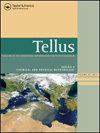根据1959年以来莫纳罗亚和南极之间的大气二氧化碳差异估算北半球陆地碳汇
IF 4.3
4区 地球科学
Q3 METEOROLOGY & ATMOSPHERIC SCIENCES
Tellus Series B-Chemical and Physical Meteorology
Pub Date : 1999-11-01
DOI:10.3402/TELLUSB.V51I5.16499
引用次数: 22
摘要
从1959年至今,莫纳罗亚和南极大气co2浓度的差异与化石燃料燃烧和水泥生产(统称为化石co2)产生的co2排放呈线性关系。化石co2零排放的外推表明,在工业革命之前,莫纳罗亚的大气co2浓度比南极低0.8 ppm,这与向北的大气输送量约为1gt℃/年(Keeling et al. 1989a)有关。质量守恒要求在海洋中有相等的向南移动。然而,我们的海洋环流和生物地球化学模型预测,工业化前的碳运输要小得多。在这里,我们提出了一个新的莫纳罗亚和南极的CO 2数据分析,使用大气的一般环流模式和2盒模式。这表明,目前莫纳罗亚和南极之间的CO 2差异除了由化石CO 2源和汇引起外,还由工业化前半球间通量0.5-0.7 Gt C年−1和北半球中纬度陆地汇0.8-1.2 Gt C年−1引起,并由1959年至今持续运行的热带森林砍伐源平衡。DOI: 10.1034 / j.1600 0889.1999.t01 - 4 - 00001. x本文章由计算机程序翻译,如有差异,请以英文原文为准。
Terrestrial carbon sink in the Northern Hemisphere estimated from the atmospheric CO2 difference between Mauna Loa and the South Pole since 1959
The diVerence between Mauna Loa and South Pole atmospheric CO 2 concentrations from 1959 to the present scales linearly with CO 2 emissions from fossil fuel burning and cement production (together called fossil CO 2 ). An extrapolation to zero fossil CO 2 emission has been used to suggest that the atmospheric CO 2 concentration at Mauna Loa was 0.8 ppm less than that at the South Pole before the industrial revolution, associated with a northward atmospheric transport of about 1 Gt C yr −1 (Keeling et al. 1989a). Mass conservation requires an equal southward transport in the ocean. However, our ocean general circulation and biogeochemistry model predicts a much smaller pre-industrial carbon transport. Here, we present a new analysis of the Mauna Loa and South Pole CO 2 data, using a general circulation model and a 2-box model of the atmosphere. It is suggested that the present CO 2 diVerence between Mauna Loa and the South Pole is caused by, in addition to fossil CO 2 sources and sinks, a pre-industrial interhemispheric flux of 0.5–0.7 Gt C yr −1 , and a terrestrial sink of 0.8–1.2 Gt C yr −1 in the mid-latitude Northern Hemisphere, balanced by a tropical deforestation source that has been operating continuously in the period from 1959 to the present. DOI: 10.1034/j.1600-0889.1999.t01-4-00001.x
求助全文
通过发布文献求助,成功后即可免费获取论文全文。
去求助
来源期刊
自引率
0.00%
发文量
3
期刊介绍:
Tellus B: Chemical and Physical Meteorology along with its sister journal Tellus A: Dynamic Meteorology and Oceanography, are the international, peer-reviewed journals of the International Meteorological Institute in Stockholm, an independent non-for-profit body integrated into the Department of Meteorology at the Faculty of Sciences of Stockholm University, Sweden. Aiming to promote the exchange of knowledge about meteorology from across a range of scientific sub-disciplines, the two journals serve an international community of researchers, policy makers, managers, media and the general public.

 求助内容:
求助内容: 应助结果提醒方式:
应助结果提醒方式:


